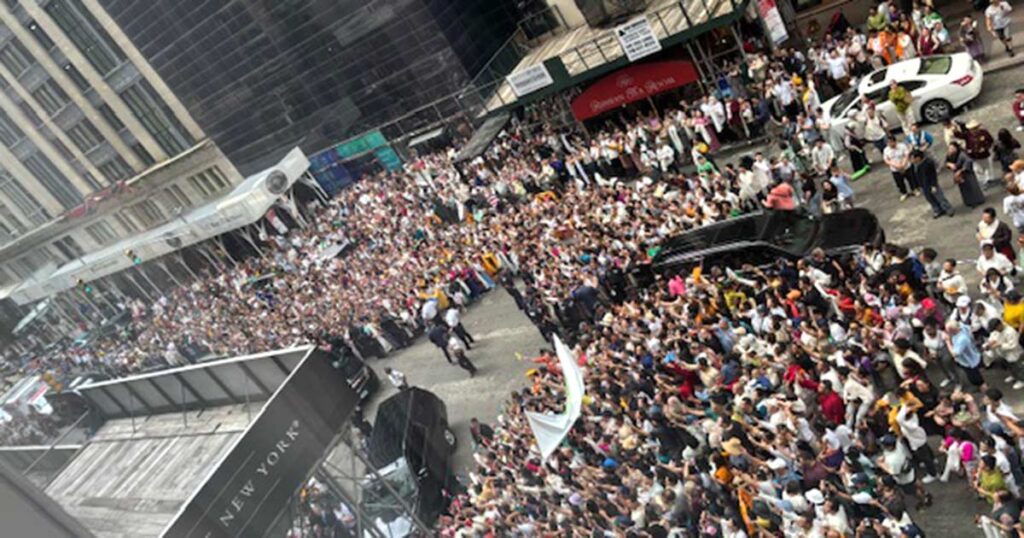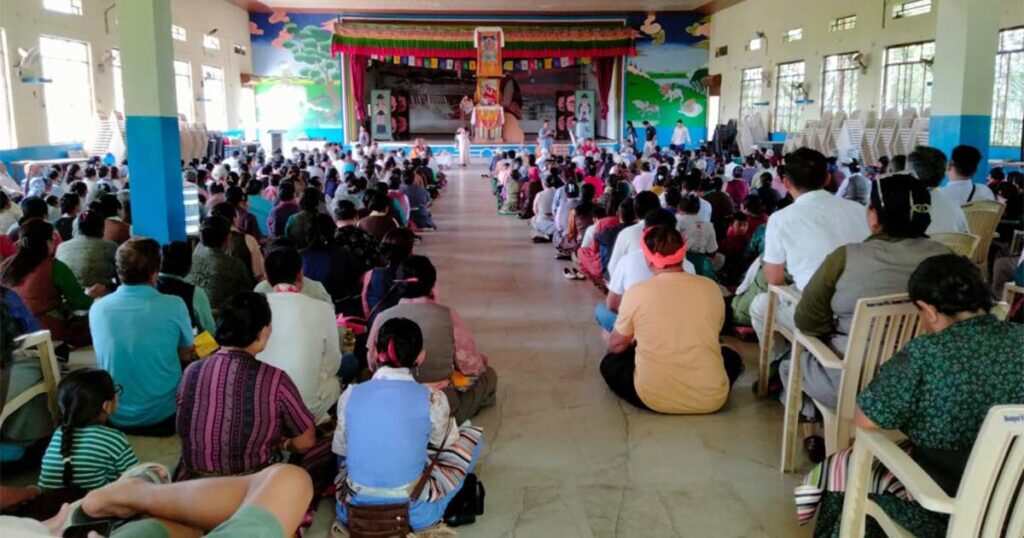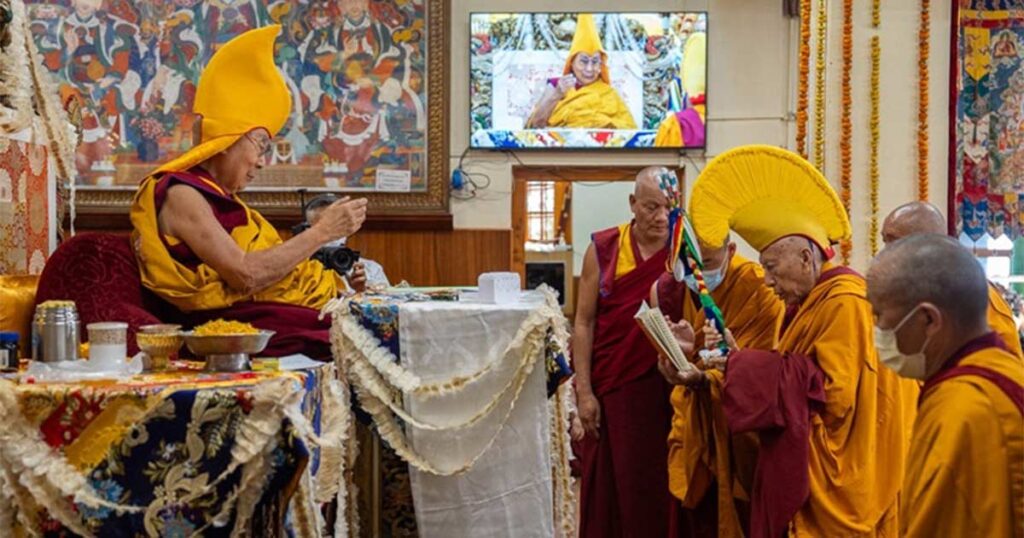As I write this, His Holiness the Dalai Lama is in the United States for treatment for a knee problem he has been having for many years. In fact, available public information shows that as early as in 2003, His Holiness alluded to having issues with his knees. During a public talk in Boston in September that year, while expressing his skepticism about those who claim special powers, His Holiness jokingly said, “If someone truly has healing power, I’d like to call about my knees.”
In recent years, it was apparent that the knee problem had worsened, and it was disconcerting for us to see His Holiness experience discomfort while walking. Therefore, like all his devotees, disciples, well-wishers, and admirers, I welcome his coming to the United States for treatment and offer my fervent prayers for its success.

A partial panoramic view of the massive crowd along the street outside the hotel in New York city welcomes H.H. the Dalai Lama on June 23, 2024 (Photo: Tencho Gyatso/ICT)
His Holiness arrived in New York after flying from New Delhi to Zurich and then to an airport in New Jersey. It was heartwarming to see several thousand devotees, including Tibetans, members of the Himalayan community, Mongolians, Vietnamese, and others gathering to welcome him at his landing venues and hotels. In the United States, in addition to the very long queue on the road from the airport in New Jersey, several blocks in New York on the street leading to the hotel were engulfed by well-wishers. The voluntary coming together of people reminds me of the perspective of H.H. the Dalai Lama shared by Rajmohan Gandhi, grandson of Mahatma Gandhi, in 2007. While participating in a panel discussion at Emory University in Atlanta in October 2007, Rajmohan Gandhi said this of the Dalai Lama, “This man without a home is loved in millions of homes. This man without a country is honored in country after country. This is no ordinary man, yet that universal pinnacle of happiness, returning home, has been denied to him. People of all kinds are at home with this homeless man.” Indeed.
When the announcement about His Holiness’ imminent treatment of his knee was made even before there was any circular from Dharamsala, devotees began to recite the mantra of the Medicine Buddha (ཏདྱཐཱ། ཨོཾ་བྷཻཥཛྱེ་བྷཻཥཛྱེ། མཧཱ་བྷཻཥཛྱེ་བྷཻཥཛྱེ། རཱཛཱ་སམུངྒ་ཏེ་སྭཱཧཱ། Tad-ya-ta: Om Be-kan-dze Be-kan-dze Ma-ha Be-kan-dze Ra-dza Sa-mung-ga-te So-ha). Invoking the Medicine Buddha is believed to be beneficial in the efficacy of medical treatments. Simultaneously, Tibetans residing in different parts of the world organized collective recitation of the mantra.

The community in the Dhoeguling Tibetan settlement in Mundgod, south India holding a collective prayer session for H.H. the Dalai Lama on June 19, 20204 (Photo credit: www.tibet.net)
Such collective prayer sessions are common in communities that follow Tibetan Buddhism. But they do not seem to be unique to us. A cursory look at the different religious traditions show that all of them embrace the special qualities of praying together. These are considered powerful moments that can spread positivity.
Supplication to Live Long
In Tibetan Buddhism one such collective prayer sessions is Tenshug (“firmly abide”), the ritual ceremony of supplicating to a lama to continue living on this earth for the sake of sentient beings. This is based on the belief that certain individuals, the Dalai Lamas being examples, with special realization have the power to decide the course of their lifespan and their rebirth. Therefore, supplicating to them is considered a spiritual way to ensure that their presence continues. As the lamas age, more such supplications are made at regular intervals by the disciples. For example, since January 2023, at least 10 Tenshugs have been offered to His Holiness by groups representing religious traditions, the Tibetan leadership, the Ladakhi community, school students and regional Tibetan communities. Later this year, the Monpa community of Arunachal Pradesh, Taiwanese Buddhists and a community representing Tibetan women are among those scheduled to make their Tenshug offerings.
I returned from a short trip to Dharamsala earlier this month where I was attending a Tenshug that the former officials of the Central Tibetan Administration (གཞུང་ཞབས་ཟུར་པ།) were offering to H.H. the Dalai Lama. We were joined by the former security personnel (སྐུ་སྲུང་ཟུར་པ།) and present & former members of the Tibetan Medical & Astro Institute (སྨན་བརྩིས་ཁང་།) in a joint supplication.
The actual ceremony, which was based on the Dolkar Tsejin Yeshin Khorlo (སྒྲོལ་དཀར་ཚེ་སྦྱིན་ཡིད་བཞིན་འཁོར་ལོའི་སྒོ་ནས་བརྟན་བཞུགས། wish-fulfilling wheel of Life-giving White Tara) ritual, took place in the morning of June 11, 2024. This date was chosen because it fell on the 5th day of the 5th Tibetan month, the actual day when H.H. the Dalai Lama was born in 1935. The ceremony included prayer sessions, symbolic auspicious offerings by Prof. Samdhong Rinpoche who was serving as the Vajra Master of the ceremony, and a brief remark by His Holiness in which he repeated his conviction of living well beyond 100 years.

Samdhong Rinpoché offering a “long-life arrow” as part of the auspicious offerings during the Tenshug on June 11, 2024. (Photo: Tenzin Choejor/OHHDL)
There were other positive initiatives taken before this ceremony. The three supplicating organizations undertook Saving and Releasing the Lives of Animal (Tsethar and Sok-lu) by purchasing over one hundred sheep in Ladakh and entrusting them to the care of a family so that the sheep do not ever have to go to the slaughterhouse.
In any case, notwithstanding the comparatively short session of the ceremony its importance equally lay in the positivity engendered by the coming together of people from different parts of the world sharing the same devotion to His Holiness and with the same prayer for his continued well-being. May our collective prayer continue to see fruition so that all of us, Tibetans and non-Tibetans, can continue to benefit from His Holiness’ presence.
